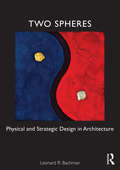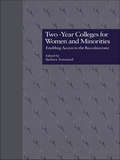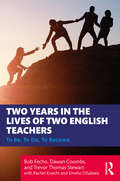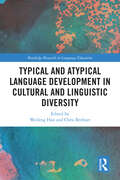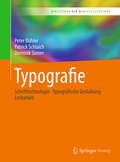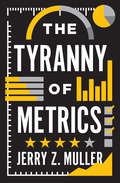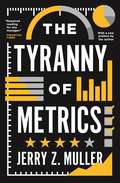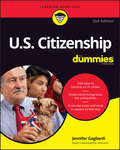- Table View
- List View
Two Spheres: Physical and Strategic Design in Architecture
by Leonard R. BachmanExplaining the connection between physical and strategic design, this book proposes an aesthetic connection between two equal aspects of architectural design: the Real and the Ideal. Addressing architectural thinkers from the broad realms of academia and practice, it is suitable either as a seminar text, a guide to contemporary design issues, or as a theoretical work. Beginning with a historical perspective, the book looks at some of the key conflicts in architectural thought that were brought about by postindustrial change. The discussion shifts to clearly describe the forms of complexity, how these have interacted with architecture and the possibilities in fully embracing complexity in architectural practice. Although there are many books focusing on complexity science, there are few that focus on the relationship between complexity and design and none which take such a comprehensive approach.
Two Spheres: Physical and Strategic Design in Architecture
by Leonard R. BachmanExplaining the connection between physical and strategic design, this book proposes an aesthetic connection between two equal aspects of architectural design: the Real and the Ideal. Addressing architectural thinkers from the broad realms of academia and practice, it is suitable either as a seminar text, a guide to contemporary design issues, or as a theoretical work. Beginning with a historical perspective, the book looks at some of the key conflicts in architectural thought that were brought about by postindustrial change. The discussion shifts to clearly describe the forms of complexity, how these have interacted with architecture and the possibilities in fully embracing complexity in architectural practice. Although there are many books focusing on complexity science, there are few that focus on the relationship between complexity and design and none which take such a comprehensive approach.
Two Teachers in the Room: Strategies for Co-Teaching Success
by Elizabeth SteinThis new co-publication from Routledge and MiddleWeb provides a wealth of practical strategies and tips to help K–12 educators co-teach more effectively. Author Elizabeth Stein presents examples of different co-teaching models and shows how to cultivate a dynamic co-teaching relationship to benefit all students. Whether you’re a brand new co-teacher or are simply looking to improve the dynamics in your classroom, the research-based strategies, vignettes, and ready-to-use assessment rubrics in this book will help you create a positive learning culture that influences all learners, teachers, and students alike. Topics include: Selecting and implementing the appropriate co-teaching model to optimize student learning; Developing an effective curriculum that plays to the strengths of both teachers; Creating a learning environment that promotes self-reflection and nurtures critical thinking; Accommodating all learners by embracing a multi-dimensional view of teacher knowledge; and Providing specific, attentive feedback to help students take charge of their learning. The book also features book discussion questions for each chapter so you can work with colleagues during book studies and PLCs.
Two Teachers in the Room: Strategies for Co-Teaching Success
by Elizabeth SteinThis new co-publication from Routledge and MiddleWeb provides a wealth of practical strategies and tips to help K–12 educators co-teach more effectively. Author Elizabeth Stein presents examples of different co-teaching models and shows how to cultivate a dynamic co-teaching relationship to benefit all students. Whether you’re a brand new co-teacher or are simply looking to improve the dynamics in your classroom, the research-based strategies, vignettes, and ready-to-use assessment rubrics in this book will help you create a positive learning culture that influences all learners, teachers, and students alike. Topics include: Selecting and implementing the appropriate co-teaching model to optimize student learning; Developing an effective curriculum that plays to the strengths of both teachers; Creating a learning environment that promotes self-reflection and nurtures critical thinking; Accommodating all learners by embracing a multi-dimensional view of teacher knowledge; and Providing specific, attentive feedback to help students take charge of their learning. The book also features book discussion questions for each chapter so you can work with colleagues during book studies and PLCs.
Two-Year College Writing Studies: Rationale and Praxis for Just Teaching
by Darin Jensen Brett GriffithsTwo-Year College Writing Studies is a comprehensive overview of the two-year college writing teaching experience within our current political and historical contexts, with examples for teachers to better enact just teaching practices in their colleges. Editors Darin Jensen and Brett Griffiths present grounded, well-theorized, and practical strategies for teachers to implement in classrooms, institutions, and geopolitical contexts to advocate more effectively for their students. Contributors draw on theories of identity, rhetorical third space, and linguistics to articulate a praxis of just teaching. They describe existing institutional challenges and opportunities that foster equity and offer cautionary tales of educational systems dismantled for short-term economic and political gains. Two-year college writing studies—when properly resourced—holds the potential to foster (or undermine) democratic ideals of civic literacy and uplift. Chapters in this volume offer case study examples of changes in departmental practices for reflection, interaction, and assessment that empower faculty to break free and engage directly with institutional, regional, state, and national constraints. By making these resilient practices visible, Two-Year College Writing Studies amplifies the voices and validates the experiences of instructors engaging in this work. It will serve generalists, specialists, and academics interested in the subdiscipline of student success pedagogies and the political histories of two-year colleges and be useful for instructors new to the field, as professional development for veteran instructors, and as an introduction for graduate students entering two-year college writing studies programs.
Two-Year Colleges for Women and Minorities: Enabling Access to the Baccalaureate (RoutledgeFalmer Studies in Higher Education)
by Barbara TownsendTwo-year colleges are often the most financially, geographically, and academically accessible means of higher education for ethnic minorities and women. This book examines five types of two-year special focus schools.
Two-Year Colleges for Women and Minorities: Enabling Access to the Baccalaureate (RoutledgeFalmer Studies in Higher Education)
by Barbara TownsendTwo-year colleges are often the most financially, geographically, and academically accessible means of higher education for ethnic minorities and women. This book examines five types of two-year special focus schools.
Two-Year-Olds in Early Years Settings: Journeys of Discovery (UK Higher Education Humanities & Social Sciences Education)
by Julia Manning-Morton Maggie ThorpThis book offers guidance on how to provide high quality provision for two year olds. With a mix of key theories, reflective questions and practice case studies the book will help the practitioner / student to reflect on the links between the development and learning needs of two year olds and how practitioners provide for them. Following the journey two year olds take through all aspects of their experience, the book starts with being at home, through transition into a setting and then considers each aspect of provision. With the case study observations of practice, practitioners and students can accompany the child on their journey in order to better understand the child’s viewpoint and to explore and analyse concepts of good quality practice and provision in order to achieve sustained improvements in provision for this age group.
Two Years in the Lives of Two English Teachers: To Be, To Do, To Become
by Bob Fecho Dawan Coombs Trevor Thomas Stewart Rachel Knecht Emelio DiSabatoThis book invites readers to explore the complexity of becoming a teacher through the stories of two novice ELA teachers, Emelio and Rachel, over the course of their first two years. The authors’ detailed, empathetic, and ethnographic approach allows space for the teachers to reveal little-seen and often overlooked "wobble moments." These moments illuminate the complexity and nuances that confront, confound, and compel teachers to remain in dialogue with practice. Documenting the journeys of two teachers with compassion and intellectual rigor, this book provides insights into and challenges preconceived notions of what it means to be a teacher. It is essential reading for preservice teachers, scholars, and researchers in English education, as well as individuals considering teaching as a profession.
Two Years in the Lives of Two English Teachers: To Be, To Do, To Become
by Bob Fecho Dawan Coombs Trevor Thomas Stewart Rachel Knecht Emelio DiSabatoThis book invites readers to explore the complexity of becoming a teacher through the stories of two novice ELA teachers, Emelio and Rachel, over the course of their first two years. The authors’ detailed, empathetic, and ethnographic approach allows space for the teachers to reveal little-seen and often overlooked "wobble moments." These moments illuminate the complexity and nuances that confront, confound, and compel teachers to remain in dialogue with practice. Documenting the journeys of two teachers with compassion and intellectual rigor, this book provides insights into and challenges preconceived notions of what it means to be a teacher. It is essential reading for preservice teachers, scholars, and researchers in English education, as well as individuals considering teaching as a profession.
Type II Uses of Technology in Education: Projects, Case Studies, and Software Applications
by Cleborne D. Maddux D. LaMont JohnsonSpark your students to actually want to learn through the creative application of technology!Type II applications in education make it possible to teach in new and more effective ways. Type II Uses of Technology in Education: Projects, Case Studies, and Software Applications clearly explains methods and strategies presently used by teachers to offer students a creative learning experience through the application of technology. Each chapter presents individual examples of how teachers have applied technology in schools and classrooms, illustrating through case studies, projects, and software applications how to effectively spark students&’ interest and learning. Type II Uses of Technology in Education is the third in a series (Internet Applications of Type II Uses of Technology in Education and Classroom Integration of Type II Uses of Technology in Education, both from Haworth) that provides a clear view of the advantages-and challenges-involved in the use of technology to enhance and actively involve students in the learning process. The applications described and discussed at length here go beyond the mundane educational functions like grading or presenting drill and practice exercises to explore fresh ways of teaching and learning. Students can become involved and actually want to learn, all through the use of creative technology application. The book also includes tables and figures to enhance understanding of the material.Type II Uses of Technology in Education discusses: data collection, analysis, and communication in student research using pocket PCs and laptops the educational effect of using a learning object as a pedagogical model rather than simply being technological in nature examples of integrated Type II activities e-learning courses using interactive video, WebCT, and on-site discussion groups electronic discussion applications in a laptop university teacher education program challenges facing students using computers to enhance and express the extent of their learning information and communication technology (ICT) integration into schools-using three illustrative case studies forward planning needed to make the difficult change to technological application for learning a case study that used problem-based learning software with at-risk students using technology to reinforce visual learning strategies digital portfolio development as a Type II application interactive computer technology in art instruction on-demand help features for effective interactive learning experience Personal Educational Tools (PETs) Type II Uses of Technology in Education: Projects, Case Studies, and Software Applications provides numerous illustrations of technology learning in action and is perfect for educators and students in programs dealing with information technology in education, and for public school personnel with interests and responsibilities in using information technology in the classroom.
Type II Uses of Technology in Education: Projects, Case Studies, and Software Applications
by Cleborne D. Maddux D. LaMont JohnsonSpark your students to actually want to learn through the creative application of technology!Type II applications in education make it possible to teach in new and more effective ways. Type II Uses of Technology in Education: Projects, Case Studies, and Software Applications clearly explains methods and strategies presently used by teachers to offer students a creative learning experience through the application of technology. Each chapter presents individual examples of how teachers have applied technology in schools and classrooms, illustrating through case studies, projects, and software applications how to effectively spark students&’ interest and learning. Type II Uses of Technology in Education is the third in a series (Internet Applications of Type II Uses of Technology in Education and Classroom Integration of Type II Uses of Technology in Education, both from Haworth) that provides a clear view of the advantages-and challenges-involved in the use of technology to enhance and actively involve students in the learning process. The applications described and discussed at length here go beyond the mundane educational functions like grading or presenting drill and practice exercises to explore fresh ways of teaching and learning. Students can become involved and actually want to learn, all through the use of creative technology application. The book also includes tables and figures to enhance understanding of the material.Type II Uses of Technology in Education discusses: data collection, analysis, and communication in student research using pocket PCs and laptops the educational effect of using a learning object as a pedagogical model rather than simply being technological in nature examples of integrated Type II activities e-learning courses using interactive video, WebCT, and on-site discussion groups electronic discussion applications in a laptop university teacher education program challenges facing students using computers to enhance and express the extent of their learning information and communication technology (ICT) integration into schools-using three illustrative case studies forward planning needed to make the difficult change to technological application for learning a case study that used problem-based learning software with at-risk students using technology to reinforce visual learning strategies digital portfolio development as a Type II application interactive computer technology in art instruction on-demand help features for effective interactive learning experience Personal Educational Tools (PETs) Type II Uses of Technology in Education: Projects, Case Studies, and Software Applications provides numerous illustrations of technology learning in action and is perfect for educators and students in programs dealing with information technology in education, and for public school personnel with interests and responsibilities in using information technology in the classroom.
Typical and Atypical Language Development in Cultural and Linguistic Diversity (Routledge Research in Language Education)
by Weifeng Han and Chris BrebnerTypical and Atypical Language Development in Cultural and Linguistic Diversity brings together state-of-the-art studies in both typical and atypical language development. Placing the topic in the context of cultural and linguistic diversity (CALD), the book offers readers serious theoretical consideration of the topic and provides implications for multilingual educational and clinical practices. The content covers a wide range of topics related to multilingual language development in CALD: typical and atypical language development in CALD, and the interface between both; the relationship between multilingual competence and academic performance in CALD; providing unbiased speech and language measures in CALD; and heritage and minority languages education in CALD. Each chapter outlines the core theoretical and practical issues and explores both theoretical and pedagogical/clinical implications in the area and possible future developments. This volume is an essential resource for all those who study, research, or are interested in multilingual development, educational linguistics, and clinical linguistics in the CALD context.
Typical and Atypical Language Development in Cultural and Linguistic Diversity (Routledge Research in Language Education)
Typical and Atypical Language Development in Cultural and Linguistic Diversity brings together state-of-the-art studies in both typical and atypical language development. Placing the topic in the context of cultural and linguistic diversity (CALD), the book offers readers serious theoretical consideration of the topic and provides implications for multilingual educational and clinical practices. The content covers a wide range of topics related to multilingual language development in CALD: typical and atypical language development in CALD, and the interface between both; the relationship between multilingual competence and academic performance in CALD; providing unbiased speech and language measures in CALD; and heritage and minority languages education in CALD. Each chapter outlines the core theoretical and practical issues and explores both theoretical and pedagogical/clinical implications in the area and possible future developments. This volume is an essential resource for all those who study, research, or are interested in multilingual development, educational linguistics, and clinical linguistics in the CALD context.
Typografie: Schrifttechnologie - Typografische Gestaltung - Lesbarkeit (Bibliothek der Mediengestaltung)
by Peter Bühler Patrick Schlaich Dominik SinnerDieser Band der „Bibliothek der Mediengestaltung“ behandelt die Schrifterkennung und Schriftklassifikation, die Lesbarkeit von Schrift und den gestalterischen und technischen Einsatz von Schriften. Außerdem werden die Schrifttechnologie und die Verwaltung von Schriften thematisiert. Für diese Bibliothek wurden die Themen des Kompendiums der Mediengestaltung neu strukturiert, vollständig überarbeitet und in ein handliches Format gebracht. Leitlinien waren hierbei die Anpassung an die Entwicklungen in der Werbe- und Medienbranche sowie die Berücksichtigung der aktuellen Rahmenpläne und Studienordnungen sowie Prüfungsanforderungen der Ausbildungs- und Studiengänge.Die Bände der „Bibliothek der Mediengestaltung“ enthalten zahlreiche praxisorientierte Aufgaben mit Musterlösungen und eignen sich als Lehr- und Arbeitsbücher an Schulen sowie Hochschulen und zum Selbststudium.
The Tyranny of Metrics
by Jerry Z. MullerHow the obsession with quantifying human performance threatens our schools, medical care, businesses, and governmentToday, organizations of all kinds are ruled by the belief that the path to success is quantifying human performance, publicizing the results, and dividing up the rewards based on the numbers. But in our zeal to instill the evaluation process with scientific rigor, we've gone from measuring performance to fixating on measuring itself. The result is a tyranny of metrics that threatens the quality of our lives and most important institutions. In this timely and powerful book, Jerry Muller uncovers the damage our obsession with metrics is causing--and shows how we can begin to fix the problem.Filled with examples from education, medicine, business and finance, government, the police and military, and philanthropy and foreign aid, this brief and accessible book explains why the seemingly irresistible pressure to quantify performance distorts and distracts, whether by encouraging "gaming the stats" or "teaching to the test." That's because what can and does get measured is not always worth measuring, may not be what we really want to know, and may draw effort away from the things we care about. Along the way, we learn why paying for measured performance doesn't work, why surgical scorecards may increase deaths, and much more. But metrics can be good when used as a complement to—rather than a replacement for—judgment based on personal experience, and Muller also gives examples of when metrics have been beneficial.Complete with a checklist of when and how to use metrics, The Tyranny of Metricsis an essential corrective to a rarely questioned trend that increasingly affects us all.
The Tyranny of Metrics
by Jerry Z. MullerHow the obsession with quantifying human performance threatens business, medicine, education, government—and the quality of our livesToday, organizations of all kinds are ruled by the belief that the path to success is quantifying human performance, publicizing the results, and dividing up the rewards based on the numbers. But in our zeal to instill the evaluation process with scientific rigor, we've gone from measuring performance to fixating on measuring itself—and this tyranny of metrics now threatens the quality of our organizations and lives. In this brief, accessible, and powerful book, Jerry Muller uncovers the damage metrics are causing and shows how we can begin to fix the problem. Filled with examples from business, medicine, education, government, and other fields, the book explains why paying for measured performance doesn't work, why surgical scorecards may increase deaths, and much more. But Muller also shows that, when used as a complement to judgment based on personal experience, metrics can be beneficial, and he includes an invaluable checklist of when and how to use them. The result is an essential corrective to a harmful trend that increasingly affects us all.
The Tyranny of Metrics
by Jerry Z. MullerHow the obsession with quantifying human performance threatens business, medicine, education, government—and the quality of our livesToday, organizations of all kinds are ruled by the belief that the path to success is quantifying human performance, publicizing the results, and dividing up the rewards based on the numbers. But in our zeal to instill the evaluation process with scientific rigor, we've gone from measuring performance to fixating on measuring itself—and this tyranny of metrics now threatens the quality of our organizations and lives. In this brief, accessible, and powerful book, Jerry Muller uncovers the damage metrics are causing and shows how we can begin to fix the problem. Filled with examples from business, medicine, education, government, and other fields, the book explains why paying for measured performance doesn't work, why surgical scorecards may increase deaths, and much more. But Muller also shows that, when used as a complement to judgment based on personal experience, metrics can be beneficial, and he includes an invaluable checklist of when and how to use them. The result is an essential corrective to a harmful trend that increasingly affects us all.
The Tyranny of Metrics
by Jerry Z. MullerHow the obsession with quantifying human performance threatens business, medicine, education, government—and the quality of our livesToday, organizations of all kinds are ruled by the belief that the path to success is quantifying human performance, publicizing the results, and dividing up the rewards based on the numbers. But in our zeal to instill the evaluation process with scientific rigor, we've gone from measuring performance to fixating on measuring itself—and this tyranny of metrics now threatens the quality of our organizations and lives. In this brief, accessible, and powerful book, Jerry Muller uncovers the damage metrics are causing and shows how we can begin to fix the problem. Filled with examples from business, medicine, education, government, and other fields, the book explains why paying for measured performance doesn't work, why surgical scorecards may increase deaths, and much more. But Muller also shows that, when used as a complement to judgment based on personal experience, metrics can be beneficial, and he includes an invaluable checklist of when and how to use them. The result is an essential corrective to a harmful trend that increasingly affects us all.
U.S. Citizenship For Dummies
by Jennifer GagliardiBecome a U.S. immigration wiz with this hands-on and practical guide to U.S. citizenship In U.S. Citizenship For Dummies, expert citizenship and ESL instructor Jennifer Gagliardi walks you through the ins and outs of the complicated process of obtaining citizenship in the United States. From preparing for test day to understanding the interview process and learning about recent changes to immigration laws, this book demystifies the legal process of transforming a foreign national into a citizen of the U.S. In this book, you’ll get: Up-to-date info on the various application and immigration forms you’ll need to complete to become a citizen Needed preparation for the all-important interview Complete coverage of the different visas and green cards available to foreign nationals and how you can qualify for themWhether you’re an immigrant-to-be who’s interested in becoming an American citizen, or you’re already a citizen but you want to bone up on U.S. history, government, and civics knowledge, U.S. Citizenship For Dummies is the perfect guide to the procedural and substantive knowledge you need to understand the American immigration system.
U.S. Citizenship For Dummies
by Jennifer GagliardiBecome a U.S. immigration wiz with this hands-on and practical guide to U.S. citizenship In U.S. Citizenship For Dummies, expert citizenship and ESL instructor Jennifer Gagliardi walks you through the ins and outs of the complicated process of obtaining citizenship in the United States. From preparing for test day to understanding the interview process and learning about recent changes to immigration laws, this book demystifies the legal process of transforming a foreign national into a citizen of the U.S. In this book, you’ll get: Up-to-date info on the various application and immigration forms you’ll need to complete to become a citizen Needed preparation for the all-important interview Complete coverage of the different visas and green cards available to foreign nationals and how you can qualify for themWhether you’re an immigrant-to-be who’s interested in becoming an American citizen, or you’re already a citizen but you want to bone up on U.S. history, government, and civics knowledge, U.S. Citizenship For Dummies is the perfect guide to the procedural and substantive knowledge you need to understand the American immigration system.
U.S. Engineering in a Global Economy (National Bureau of Economic Research Conference Report)
by Richard B. Freeman Hal SalzmanSince the late 1950s, the engineering job market in the United States has been fraught with fears of a shortage of engineering skill and talent. U.S. Engineering in a Global Economy brings clarity to issues of supply and demand in this important market. Following a general overview of engineering-labor market trends, the volume examines the educational pathways of undergraduate engineers and their entry into the labor market, the impact of engineers working in firms on productivity and innovation, and different dimensions of the changing engineering labor market, from licensing to changes in demand and guest worker programs. The volume provides insights on engineering education, practice, and careers that can inform educational institutions, funding agencies, and policy makers about the challenges facing the United States in developing its engineering workforce in the global economy.
U.S. Engineering in a Global Economy (National Bureau of Economic Research Conference Report)
by Richard B. Freeman and Hal SalzmanSince the late 1950s, the engineering job market in the United States has been fraught with fears of a shortage of engineering skill and talent. U.S. Engineering in a Global Economy brings clarity to issues of supply and demand in this important market. Following a general overview of engineering-labor market trends, the volume examines the educational pathways of undergraduate engineers and their entry into the labor market, the impact of engineers working in firms on productivity and innovation, and different dimensions of the changing engineering labor market, from licensing to changes in demand and guest worker programs. The volume provides insights on engineering education, practice, and careers that can inform educational institutions, funding agencies, and policy makers about the challenges facing the United States in developing its engineering workforce in the global economy.
